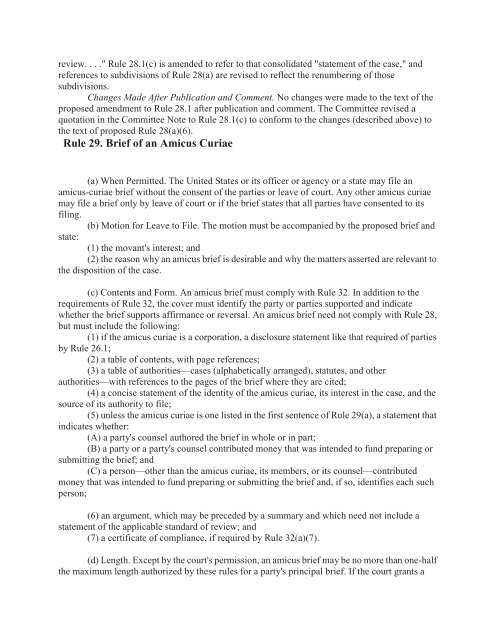Federal Rules of Appellate Procedure 2014-2015, 2014a
Federal Rules of Appellate Procedure 2014-2015, 2014a
Federal Rules of Appellate Procedure 2014-2015, 2014a
You also want an ePaper? Increase the reach of your titles
YUMPU automatically turns print PDFs into web optimized ePapers that Google loves.
eview. . . ." Rule 28.1(c) is amended to refer to that consolidated "statement <strong>of</strong> the case," and<br />
references to subdivisions <strong>of</strong> Rule 28(a) are revised to reflect the renumbering <strong>of</strong> those<br />
subdivisions.<br />
Changes Made After Publication and Comment. No changes were made to the text <strong>of</strong> the<br />
proposed amendment to Rule 28.1 after publication and comment. The Committee revised a<br />
quotation in the Committee Note to Rule 28.1(c) to conform to the changes (described above) to<br />
the text <strong>of</strong> proposed Rule 28(a)(6).<br />
Rule 29. Brief <strong>of</strong> an Amicus Curiae<br />
(a) When Permitted. The United States or its <strong>of</strong>ficer or agency or a state may file an<br />
amicus-curiae brief without the consent <strong>of</strong> the parties or leave <strong>of</strong> court. Any other amicus curiae<br />
may file a brief only by leave <strong>of</strong> court or if the brief states that all parties have consented to its<br />
filing.<br />
(b) Motion for Leave to File. The motion must be accompanied by the proposed brief and<br />
state:<br />
(1) the movant's interest; and<br />
(2) the reason why an amicus brief is desirable and why the matters asserted are relevant to<br />
the disposition <strong>of</strong> the case.<br />
(c) Contents and Form. An amicus brief must comply with Rule 32. In addition to the<br />
requirements <strong>of</strong> Rule 32, the cover must identify the party or parties supported and indicate<br />
whether the brief supports affirmance or reversal. An amicus brief need not comply with Rule 28,<br />
but must include the following:<br />
(1) if the amicus curiae is a corporation, a disclosure statement like that required <strong>of</strong> parties<br />
by Rule 26.1;<br />
(2) a table <strong>of</strong> contents, with page references;<br />
(3) a table <strong>of</strong> authorities—cases (alphabetically arranged), statutes, and other<br />
authorities—with references to the pages <strong>of</strong> the brief where they are cited;<br />
(4) a concise statement <strong>of</strong> the identity <strong>of</strong> the amicus curiae, its interest in the case, and the<br />
source <strong>of</strong> its authority to file;<br />
(5) unless the amicus curiae is one listed in the first sentence <strong>of</strong> Rule 29(a), a statement that<br />
indicates whether:<br />
(A) a party's counsel authored the brief in whole or in part;<br />
(B) a party or a party's counsel contributed money that was intended to fund preparing or<br />
submitting the brief; and<br />
(C) a person—other than the amicus curiae, its members, or its counsel—contributed<br />
money that was intended to fund preparing or submitting the brief and, if so, identifies each such<br />
person;<br />
(6) an argument, which may be preceded by a summary and which need not include a<br />
statement <strong>of</strong> the applicable standard <strong>of</strong> review; and<br />
(7) a certificate <strong>of</strong> compliance, if required by Rule 32(a)(7).<br />
(d) Length. Except by the court's permission, an amicus brief may be no more than one-half<br />
the maximum length authorized by these rules for a party's principal brief. If the court grants a


















